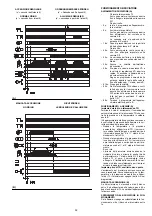
17
EINSTELLUNG DES FLAMMKOPFS
An dieser Stelle der Installation sind Flammrohr
und Muffe gem. Abb. (A) am Kessel befestigt.
Die Einstellung des Flammkopfs ist daher
besonders bequem, sie hŠngt einzig und allein
von der abgegebenen Brennerleistung auf der
2. Stufe ab.
Dieser Wert mu§ daher unbedingt vor der Ein-
stellung des Flammkopfs festgelegt werden.
Am Flammkopf sind drei Einstellungen vorgese-
hen:
¥ der Au§enluft R1;
¥ der Zentralluft R2;
¥ des Gases R3.
Im Diagrammen (C) die Kerbe ausÞndig
machen, auf die Luft und Gas einzustellen sind,
dann:
Einstellung der Au§enluft (A)
Die Schraube 4)(A) verdrehen, bis die gefun-
dene Kerbe mit der Vorderߊche 5)(A) des Flan-
sches zusammenfŠllt.
Gaseinstellung (B)
Die Schrauben 1)(B) und 4)(B) lockern und den
Stellring 2) soweit drehen, bis die gefundene
Kerbe mit dem Indexstift 3) zusammenfŠllt.
Einstellung der
Zentralluft (B)
Die Drossel 5) drehen, bis die gefundene Kerbe
mit der Schraube 4) zusammenfŠllt.
Die Schrauben 1) und 4) klemmen.
Beispiel - RS 40 BLU
Brennerleistung = 390 kW.
Dem Diagramm (C) wird entnommen, da§ die
Gas- und Lufteinstellungen fŸr diese Leistung
sind:
¥ Au§enluft:
R1 = 3;
¥ Mitteluft:
R2 = 2;
¥ Gas:
R3 = 0.
MERKE
Die Diagramm (C) zeigen die optimaleEinstel-
lung des Flammkopfs. Falls der Gaszuleistungs-
druck besonders niedrig ist und dadurch der auf
Seite 12 angegebene Druck in 2. Stufe nicht
erreicht werden kann, und falls der Stellring
2)(B) nur teilweise gešffnet ist, kann der letztere
um weitere 1-2 Kerben gešffnet werden.
Entsprechend diesem Beispiel ist auf Seite 12
ersichtlich, da§ ein Brenner RS 40 BLU mit 390
kW Leistung ca. 12 mbar Druck am Anschlu§
6)(A) erfordert. Liegt dieser Druck nicht an, den
Stellring 2)(B) auf die 1-2 Kerbe šffnen.
Die Verbrennung mu§ zufriedenstellend und
ohne
Verpuffungen erfolgen.
Nach Beendung der Flammkopfeinstellung den
Brenner auf die Gleitschienen 3) in ca. 100 mm
Abstand zur Muffe 5) - einbauen - Brennerposi-
tion in Abb. (B)S. 14 - das FŸhler- und Elektro-
denkabel einsetzen und anschlie§end den
Brenner bis zur Muffe schieben, Brennerposi-
tion in Abb. (D).
Die Schrauben 2) auf die Gleitschienen 3) ein-
setzen.
Den Brenner mit der Schraube 1) an der Muffe
befestigen und den Splint in eine der zwei FŸh-
rungen 3) wieder einsetzen.
Das Gelenk 8) wieder am Skalensegment 7)
einhŠngen.
Wichtiger Hinweis
Beim Schlie§en des Brenners auf die zwei Gleit-
schienen ist es ratsam, das Hochspannungska-
bel und das Kabel des FlammenfŸhlers
vorsichtig nach au§en zu ziehen, bis sie leicht
gespannt sind.
COMBUSTION HEAD SETTING
Installation operations are now at the stage
where the blast tube and sleeve are secured to
the boiler as shown in Þg. (A). It is now a very
simple matter to set up the combustion head, as
this depends solely on the output developed by
the burner in 2nd stage operation.
It is therefore essential to establish this value
before proceeding to set up the combustion
head.
There are two adjustments to make on the
head:
¥ outside air R1;
¥ central air R2;
¥ gas deliveries R3.
In diagram (C) Þnd the notch to use for adjusting
the air and the gas, and then proceed as follows:
Outside air adjustment (A)
Turn screw 4)(A) until the notch identiÞed is
aligned with the front surface 5)(A) of the ßange.
Gas adjustment (B)
Loosen screws 1)(B) and 4)(B) and turn ring 2)
until the notch identiÞed is aligned with index 3).
Central air adjustment (B)
Turn choke 5) until the notch identiÞed is aligned
with screw 4).
Tighten the screws 1) and 4) fully down.
Example - RS 40 BLU
Burner output = 390 kW.
If we consult diagram (C) we Þnd that for this
output the adjustments are:
¥ outside air:
R1 = 3;
¥ central air:
R2 = 2;
¥ gas:
R3 = 0.
NOTE
Diagram (C) show the ideal settings for the com-
bustion head. If the gas mains pressure is too
low to reach the 2nd stage operation pressure
indicated on page 12, and if the ring 2)(B) is not
fully open, it can be opened wider by 1 or 2
notches.
Continuing with the previous example, page 12
indicates that for burner RS 40 BLU with output
of 390 kW a pressure of approximately 12
mbar is necessary at test point 6)(A). If this
pressure cannot be reached, open the ring 2)(B)
to notch 1 or 2.
Make sure that the combustion characteristics
are satisfactory and free of pulsations.
Once you have Þnished setting up the head, reÞt
the burner 4)(D) to the slide bars 3) at approxi-
mately 100 mm from the sleeve 5) - burner posi-
tioned as shown in Þg. (B)p. 14 - insert the ßame
detection probe cable and the ignition electrode
cable and then slide the burner up to the sleeve
so that it is positioned as shown in Þg. (D).
ReÞt screws 2) on slide bars 3).
Secure the burner to the sleeve by tightening
screw 1) and then reÞt the split pin into one of
two slide bars 3).
Reconnect the articulation 8) to the graduated
sector 7).
Important
When Þtting the burner on the two slide bars, it
is advisable to gently draw out the high tension
cable and ßame detection probe cable until they
are slightly stretched.
REGLAGE TETE DE COMBUSTION
A ce stade de l'installation, buse et manchon
sont ÞxŽs ˆ la chaudi•re comme indiquŽ sur la
Þg. (A). Le rŽglage de la t•te de combustion est
donc particuli•rement facile, et dŽpend unique-
ment de la puissance dŽveloppŽe par le bržleur
en 2•me allure.
C'est pourquoi, il faut Þxer cette valeur avant de
rŽgler la t•te de combustion.
Deux rŽglages de la t•te sont prŽvus:
¥ celui-ci de l'air extŽrieure R1;
¥ celui-ci de l'air centrale R2;
¥ celui-ci du gaz R3.
Trouver sur le diagramme (C) l'encoche sur
laquelle rŽgler l'air et le gaz.
RŽglage de l'air extŽrieure (A)
Faire pivoter la vis 4)(A) jusqu'ˆ faire correspon-
dre l'encoche trouvŽe avec le plan antŽrieur
5)(A) de la bride.
RŽglage du gaz (B)
Desserrer les vis 1)(B) et 4)(B) et faire tourner la
bague 2) jusqu'ˆ faire correspondre l'encoche
avec le rep•re 3).
RŽglage de l'air centrale
(B)
Tourner lÕŽtrangleur 5) jusquÕˆ faire correspon-
dre lÕencoche trouvŽe avec la vis 4).
Bloquer les vis 1) et 4).
Exemple - RS 40 BLU
Puissance du bržleur = 390 kW.
Le diagramme (C) indique que pour cette puis-
sance les rŽglages sont:
¥ air extŽrne:
R1 = 3;
¥ air centrale:
R2 = 2;
¥ gaz:
R3 = 0.
NOTE
Les diagrammes (C) indiquent le rŽglage opti-
mal de la t•te. Si la pression du rŽseau dÕali-
mentation en gaz est tr•s faible et ne permet
pas dÕatteindre la pression indiquŽe page 12 en
2•me allure, et si la bague 2)(B) nÕest ouverture
quÕen partie, il est possible dÕouvrir encore cette
bague de 1 ou 2 encoches.
Pour continuer l'exemple prŽcŽdent, la page 12
indique que pour un bržleur RS 40 BLU de puis-
sance 390 kW il faut 12 mbar environ de pres-
sion ˆ la prise 6)(A). Si cette pression n'est pas
disponible, ouvrir la bague 2)(B) de 1 ou 2 enco-
ches.
Contr™ler que la combustion soit satisfaisante et
sans saccades.
Une fois terminŽ le rŽglage de la t•te, remonter
le bržleur 4)(D) sur les guides 3) ˆ environ 100
mm du manchon 5) - bržleur dans la position
illustrŽe Þg. (B)p. 14 - insŽrer les c‰bles de la
sonde et de l'Žlectrode et ensuite faire coulisser
le bržleur jusqu'au manchon, bržleur dans la
position illustrŽe Þg. (D).
Replacer les vis 2) sur les guides 3).
Fixer le bržleur au manchon avec la vis 1) et
remplacer la goupille dans une des deux guides
3).
Raccrocher la rotule 8) au secteur graduŽ 7).
Attention
Au moment de la fermeture du bržleur sur les
deux guides, il faut tirer dŽlicatement vers l'extŽ-
rieur le c‰ble de haute tension et le petit c‰ble
de la sonde de dŽtection ßamme, jusqu'ˆ ce
qu'ils soient lŽg•rement tendus.
















































